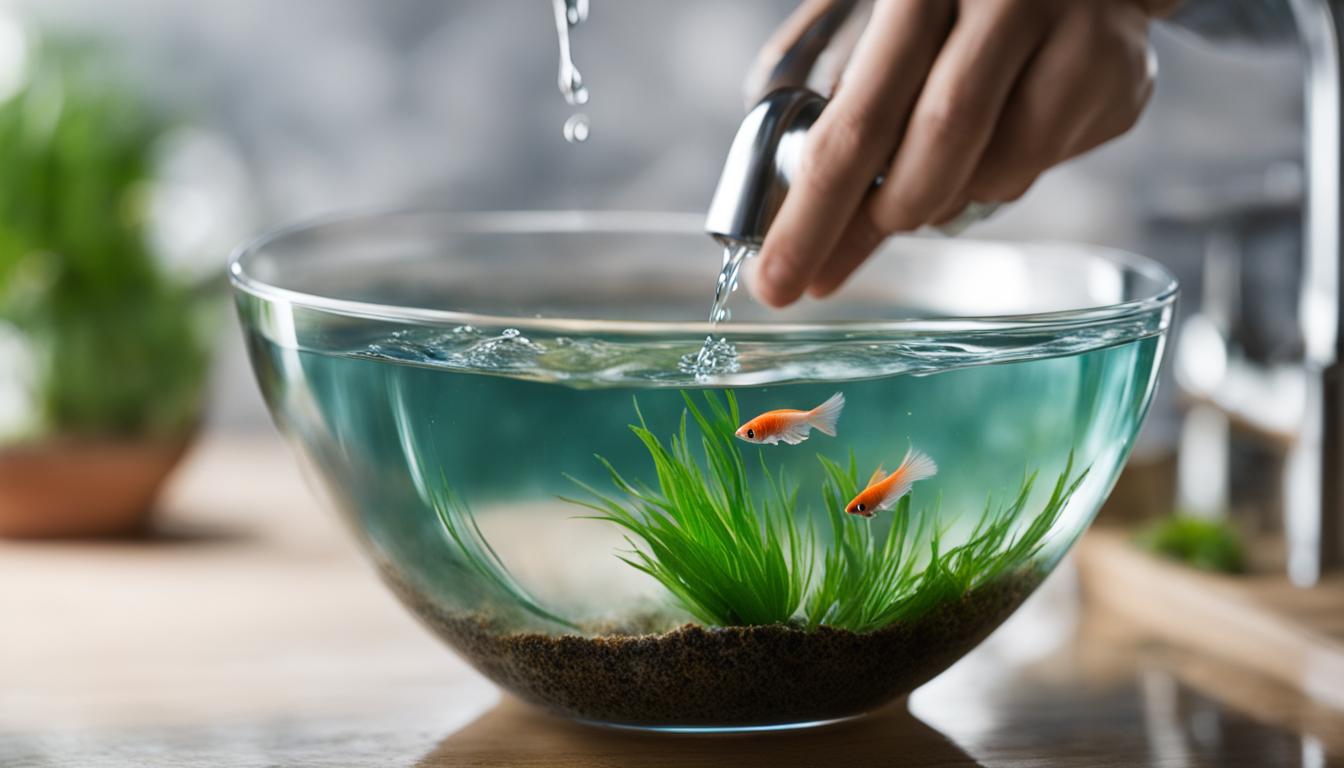Last Updated on 2 years by admin
Keeping your betta fish healthy and happy requires proper care and a clean environment. One of the essential aspects of betta fish care is regular cleaning of their bowl. However, washing a betta fish bowl can be a bit daunting for pet owners, especially those who are new to fishkeeping.
In this comprehensive guide, we’ll provide you with step-by-step instructions on how to efficiently wash your betta fish bowl. Following these best practices for betta fish bowl cleaning will help ensure your fish’s well-being and happiness.
Key Takeaways
- Clean your betta fish bowl regularly to keep your fish healthy and happy
- Assemble all the necessary supplies before starting the cleaning process
- Safely remove your fish from the bowl before cleaning
- Follow the step-by-step process of scrubbing, rinsing, and disinfecting the bowl
- Refill the bowl with fresh water and reintroduce your betta fish safely
Understanding Betta Fish Bowl Cleaning and Maintenance
As a responsible betta fish owner, providing a clean and healthy environment for your fish should be a top priority. Regular betta fish bowl cleaning and maintenance are important for ensuring your fish’s well-being and happiness.
Over time, waste and uneaten food can accumulate in the bowl, leading to poor water quality and potentially harmful conditions for your fish. This buildup can also damage the bowl’s accessories and decorations, making them less effective or even unusable.
Regular cleaning and maintenance of your betta fish bowl can help prevent these issues and keep your fish happy and healthy for years to come.
To ensure proper cleaning and maintenance, it’s important to have a basic understanding of your betta fish’s habitat and the conditions necessary for their well-being.
| Important factors for betta fish bowl cleaning and maintenance: |
|---|
| Water temperature: Betta fish are tropical fish and require warm water temperatures between 76°F and 82°F. Keeping the water at a consistent temperature is critical to your fish’s health. |
| Water pH level: Betta fish prefer slightly acidic water with a pH level between 6.5 and 7.5. Consistently monitoring and adjusting the pH level is essential for maintaining a healthy environment for your fish. |
| Water filtration: A good filtration system is essential for removing waste and debris from the water, providing cleaner and healthier conditions for your fish. |
| Bowl size: Betta fish require a minimum of 2.5 gallons of water to thrive. A larger bowl provides a more stable and healthier environment for your fish. |
By understanding these factors and their importance for your fish’s well-being, you’ll be better equipped to maintain a clean and healthy betta fish bowl.
Gather the Necessary Supplies
Before you begin cleaning your betta fish bowl, make sure you have gathered all the necessary supplies. This will ensure that you don’t have to interrupt the cleaning process to go find something you need. Here’s a list of the essential items you’ll need:
| Supplies | Why You Need It |
|---|---|
| Bowl or Bucket | You need a separate container to hold your betta fish while you clean his bowl. Use a small, clean bowl or bucket. |
| Net | A small net will help you safely remove your betta fish from his bowl. |
| Water Conditioner | Water conditioner helps to neutralize any harmful chemicals that may be in the water. It is important to add water conditioner to your betta fish’s water every time you clean his bowl. |
| Clean Cloth or Sponge | You will need a clean, soft cloth or sponge to scrub the bowl. Do not use any soap or cleaning solutions as it may be harmful to your fish. |
| Water Testing Kit | It is important to test the water in your betta fish’s bowl regularly to ensure that the water is at the right temperature and pH level. Use a water testing kit to keep the water in optimal condition. |
| Bucket | You’ll need a bucket to dispose of the old water. |
| Towels or Paper Towels | You’ll need towels or paper towels to dry the bowl and accessories after cleaning. |
Having all the necessary supplies before you begin the cleaning process will help ensure that the process is quick and efficient and your betta fish remains healthy.

Prepare the Fresh Water
After emptying and scrubbing the betta fish bowl, it’s essential to prepare fresh water for your fish. Tap water can contain chlorine and other contaminants harmful to your betta fish, so it’s necessary to treat it adequately before adding it to the bowl. Follow these steps:
- Fill a clean container with tap water.
- Add a dechlorinator solution to the water. Dechlorinators are available in most pet stores and help remove chlorine and other harmful chemicals from the water.
- If you’re using bottled or purified water, you may skip the dechlorinator step.
- Allow the water to sit for at least an hour to ensure it’s at room temperature before adding it to the bowl.
- Check the water’s pH level using an aquarium testing kit, and adjust it if necessary. Betta fish prefer a slightly acidic pH level between 6.5 and 7.5.
Preparing fresh water for your betta fish is crucial in maintaining its health and happiness. By taking these steps, you can ensure a clean and safe environment for your fish to thrive.
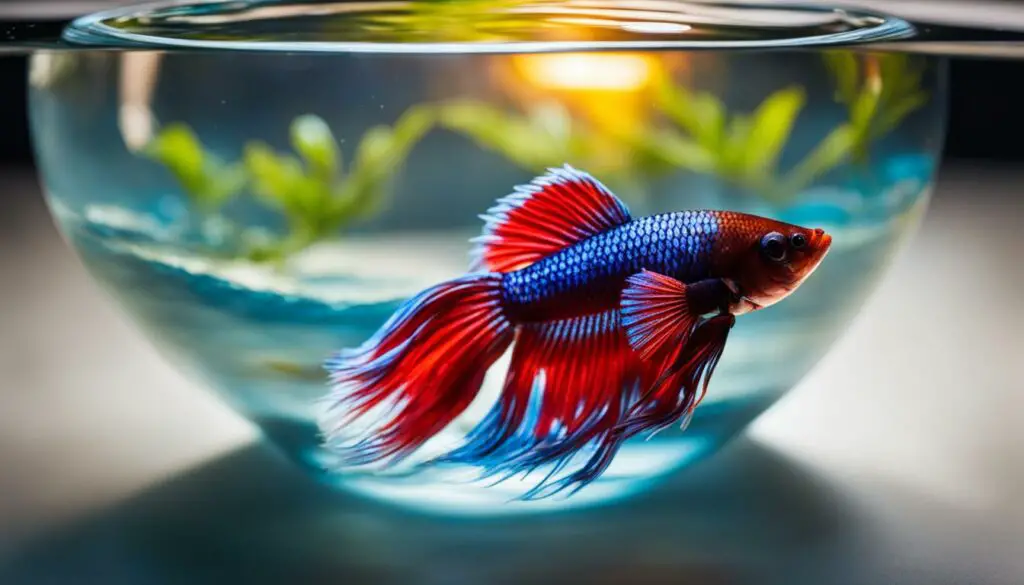
Remove Your Betta Fish
Before starting the cleaning process, it’s crucial to remove your betta fish to ensure its safety and minimize stress. Follow these step-by-step instructions:
- Turn off any electrical equipment around the bowl to avoid electrocuting your fish.
- Prepare a small container or net to transfer your fish.
- Carefully scoop your fish with the net or transfer it to the container.
- Place the container in a safe location away from direct sunlight and cold drafts.
Note: Do not use soap or cleaning products to clean the bowl while your fish is still inside.
Once the cleaning process is complete, gently reintroduce your fish to its clean bowl. Gradually add small amounts of the clean water to the container or net before finally transferring your fish back to the bowl. This step will acclimate your fish to the new water conditions and minimize any potential stress.
Now that your betta fish is safely removed, it’s time to move on to the next step.
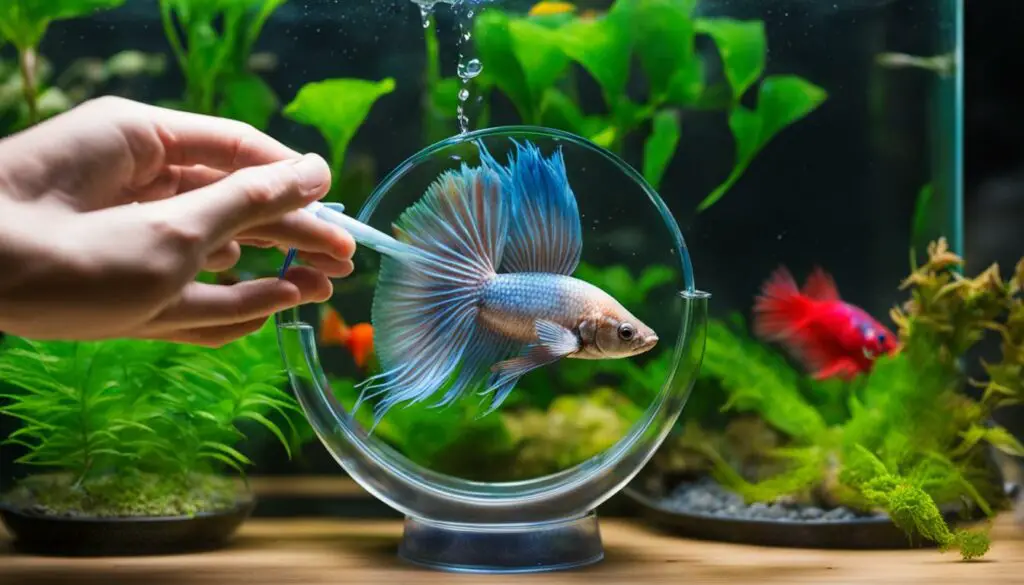
Empty and Scrub the Bowl
The next step is to empty and scrub the bowl thoroughly. This process is essential to remove any dirt, debris, or harmful bacteria that may have accumulated in your betta fish bowl. Here are some step-by-step instructions for emptying and scrubbing the bowl:
- Remove any accessories or decorations from the bowl.
- Carefully pour out the water and any debris into the sink or a bucket.
- Use a soft sponge or brush to scrub the inside of the bowl gently. Be sure to clean all areas, including the corners, sides, and bottom. Avoid using soap or detergents, as these can be harmful to your betta fish.
- Rinse the bowl thoroughly with clean water until all dirt and debris are completely removed.
- Be sure to scrub and rinse any accessories or decorations as well before returning them to the bowl.
It’s important to note that using harsh chemicals or abrasive cleaning solutions can harm your betta fish. Therefore, it’s best to avoid using any chemicals and stick to simple physical scrubbing using a soft sponge or brush.
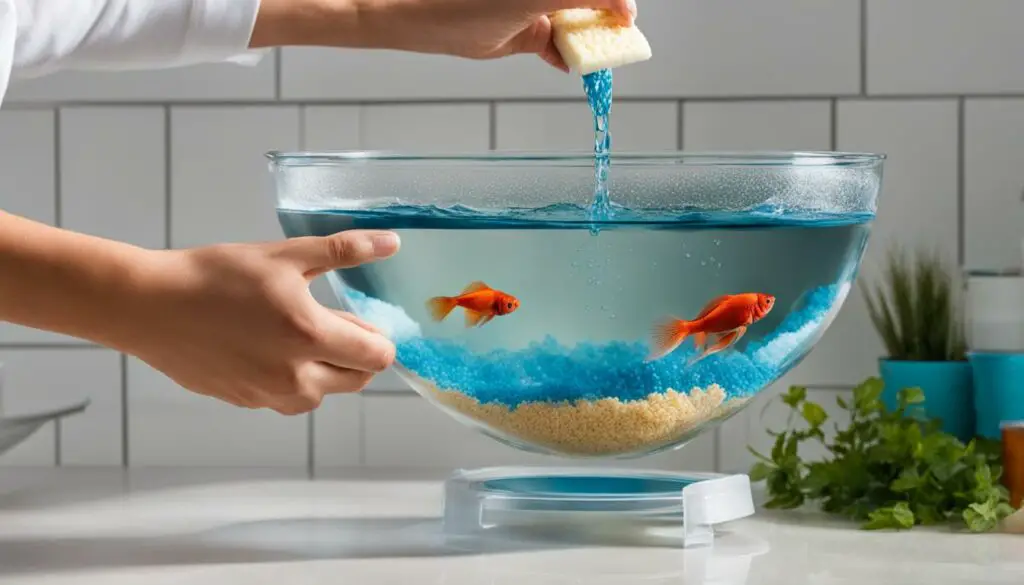
Empty and Scrub the Bowl – Best Practices
Here are some additional tips to keep in mind when emptying and scrubbing your betta fish bowl:
- Always use fresh, clean water to rinse the bowl.
- Don’t rush the scrubbing process. Take your time to ensure that every part of the bowl is thoroughly scrubbed and rinsed.
- Use a separate sponge or brush for each bowl or tank to avoid cross-contamination.
- Consider using a gravel siphon to remove any debris that has accumulated at the bottom of the bowl.
- Perform this cleaning process on a regular basis to maintain a healthy and happy environment for your betta fish.
Remember, a clean and well-maintained betta fish bowl is vital to the health and wellbeing of your fish. Taking the time to empty and scrub the bowl regularly is an essential component of proper betta fish bowl cleaning and maintenance.
Rinse and Disinfect the Bowl
After scrubbing the bowl, it’s time to rinse and disinfect it thoroughly. This will help ensure that your betta fish bowl is free from harmful bacteria, parasites, and other microorganisms that can pose a risk to your fish’s health.
Start by rinsing the bowl with clean water. Use a gentle stream of water, being careful not to damage any of the decorations or accessories in the bowl. Rinse until all the soap residue is gone.
Next, prepare a disinfecting solution by mixing one part white vinegar with four parts water. Vinegar is effective in killing bacteria and germs that may be present in the bowl. You can also use a commercial aquarium disinfectant, but make sure to follow the instructions carefully and rinse the bowl thoroughly after using it.
Once the solution is ready, dip a clean cloth or sponge into the solution and wipe the bowl’s surfaces. Pay special attention to areas that are hard to reach or that have a lot of buildup. Be thorough in your cleaning, but don’t use too much force that could scratch or damage the bowl.
After disinfecting, rinse the bowl again with clean water until there is no more vinegar smell or taste. It’s essential to ensure that no traces of vinegar are left behind, as it can be harmful to your betta fish.

Important Tips:
- Never use soap or other detergents to clean the decorations and accessories, as they can harm your betta fish. Use a gentle brush or sponge to clean them thoroughly, and rinse them well with clean water.
- Always use clean water when rinsing and disinfecting the bowl to avoid contamination.
- Do not use bleach or other harsh chemicals to clean the bowl, as they can be harmful to your betta fish.
- Make sure to wash your hands before handling the bowl or any of its contents to prevent introducing harmful bacteria or germs to the water.
“A clean and disinfected bowl is essential to maintain a healthy and happy environment for your betta fish.”
Clean the Decorations and Accessories
While you’re cleaning your betta fish bowl, don’t forget to clean the decorations and accessories too. These items can often harbor harmful bacteria and debris, so it’s essential to give them a good cleaning to prevent any health issues for your fish.
First, remove all decorations and accessories from the bowl and gently scrub them with a soft-bristled brush under running water. Avoid using soap or any other cleaning agents, as they can leave residue harmful to your fish.
For tough stains or debris buildup, you can soak the items in a solution of one-part vinegar and three-parts water for 15-20 minutes before rinsing them thoroughly.
Once the decorations and accessories are clean, it’s essential to ensure they are completely dry before returning them to the bowl. Use a dry towel or let them air dry for a few hours to remove any excess moisture.
By regularly cleaning and maintaining your betta fish bowl’s decorations and accessories, you can help ensure your fish’s health and happiness.
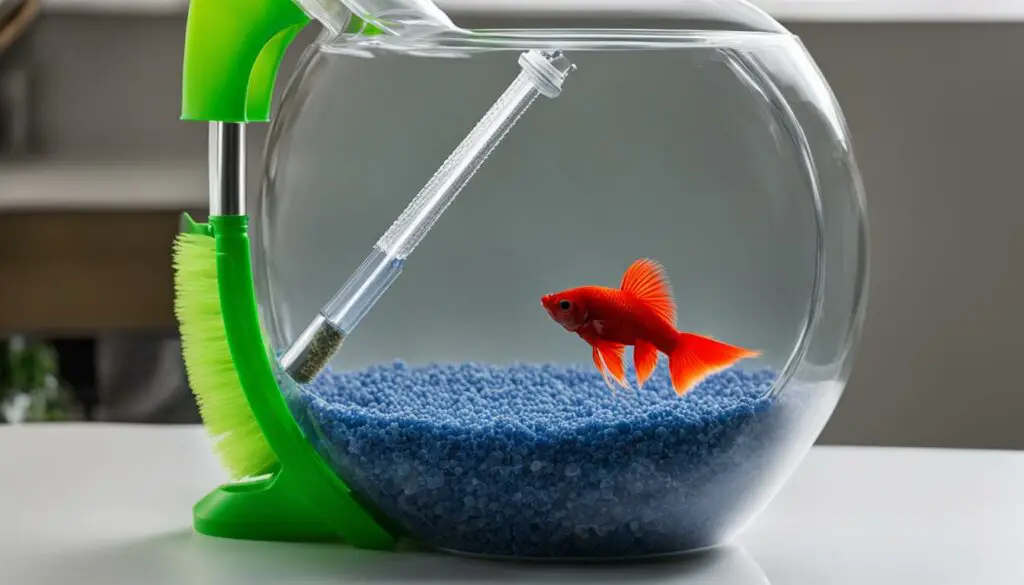
Refill the Bowl with Fresh Water
Now that you’ve completed the cleaning process, it’s time to refill the bowl with fresh water. This is an essential step in ensuring your betta fish’s health and happiness. Follow these steps to provide the right water conditions:
- Fill a clean container with room temperature water. Using hot or cold water can shock or harm your fish.
- If your tap water contains chlorine or other chemicals, treat the water with a water conditioner. Follow the instructions on the product label for the correct dosage.
- Test the water using a water testing kit to ensure a pH level of 7.0. Bettas prefer slightly acidic water, with a pH range of 6.5 to 7.5.
- Slowly pour the water into the bowl. Avoid splashing or disturbing the gravel, as this could cause debris to settle and cloud the water.
- Fill the bowl until it’s about 80% full. This will give your betta fish enough swimming space while also minimizing the risk of splashing or overflowing.
Once you’ve refilled the bowl with fresh water, it’s important to monitor the water conditions regularly. Check the water temperature, pH levels, and water hardness weekly to ensure your betta fish’s health and comfort.
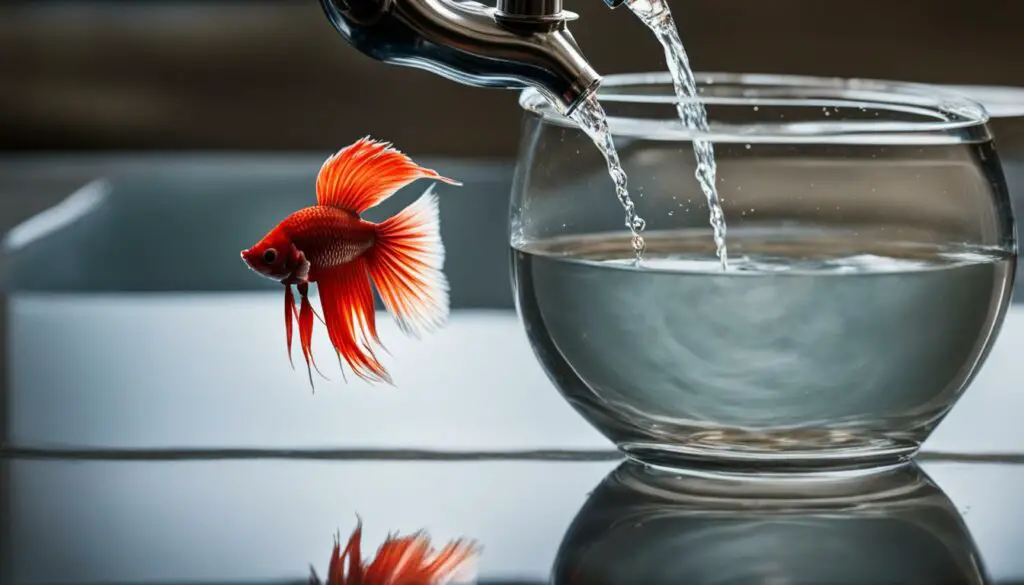
Reintroduce Your Betta Fish to the Clean Bowl
Now that your betta fish bowl is clean and filled with fresh water, it’s time to reintroduce your fish. Follow these steps to ensure a smooth transition and minimize stress on your fish.
- Turn off the aquarium lights and dim the room lights to make the reintroduction less stressful for your fish.
- Float the fish in its container on the water’s surface for around 15 minutes to acclimate it to the bowl’s temperature. This is especially important if you’ve used warmer water to clean the bowl to prevent shock to the fish.
- Gently tip the container allowing the fish to swim out into the bowl.
- Observe your fish closely for a few hours to ensure that it is swimming and behaving normally.
- Avoid overfeeding your fish immediately after reintroduction as it can cause stress and lead to health problems.
By following these steps, your betta fish will adjust smoothly to its newly cleaned and comfortable environment.

Conclusion
Congratulations on learning how to wash a betta fish bowl efficiently! Proper cleaning and maintenance of your betta fish bowl are essential for your fish’s health and happiness. Regular cleaning will help ensure your bowl is a safe and comfortable environment for your betta fish.
Remember to always follow the step-by-step instructions and best practices outlined in this guide to ensure a thorough and efficient cleaning process. Avoid using harsh chemicals or cleaning agents that could harm your fish. Use the right tools and supplies and maintain the right water conditions to keep your fish healthy.
By taking care of your betta fish bowl, you are taking care of your betta fish. Enjoy the beauty of a well-maintained betta fish bowl, and watch your fish thrive in its clean and comfortable habitat.
This concludes our ultimate guide on how to wash a betta fish bowl efficiently. We hope you found it helpful and informative. For more information on betta fish bowl cleaning and maintenance, don’t hesitate to consult with a professional or do further research online.
Thank you for reading!
FAQ
Why is regular betta fish bowl cleaning important?
Regular cleaning is important to maintain a clean and healthy environment for your betta fish. It helps remove harmful bacteria, waste, and debris that can negatively impact their health and well-being.
How often should I clean my betta fish bowl?
It is recommended to clean your betta fish bowl once every 1-2 weeks. However, the frequency may vary depending on the size of your bowl and the number of fish. Keep an eye on the water quality and cleanliness to determine the best cleaning schedule for your specific setup.
What should I use to clean my betta fish bowl?
When cleaning your betta fish bowl, use mild soap and warm water. Avoid using any harsh chemicals or detergents as they can be harmful to your fish. Also, make sure to use separate cleaning supplies that are designated solely for your fish tank to prevent contamination.
How do I safely remove my betta fish from the bowl?
To safely remove your betta fish from the bowl, use a clean net or a cup. Gently scoop them up and transfer them to a separate container filled with water from the tank. Ensure the container has proper water conditions and is free from any contaminants.
Can I clean the betta fish bowl accessories with soap?
Yes, you can clean the betta fish bowl accessories with mild soap and warm water. Rinse them thoroughly to remove any soap residue before returning them to the bowl. It is essential to keep the accessories clean to maintain a healthy and aesthetically pleasing environment for your betta fish.
Should I remove the plants from the bowl during cleaning?
It is recommended to remove live plants from the bowl during the cleaning process. This will prevent any damage to the plants and allow you to thoroughly clean the bowl without any obstructions. Return the plants to the bowl after completing the cleaning and rinsing process.
How can I ensure the water temperature is suitable for my betta fish?
Before reintroducing your betta fish to the clean bowl, make sure the water temperature matches their preferred range, which is around 76-82°F (24-28°C). Use a reliable aquarium thermometer to monitor and adjust the water temperature accordingly.
Can I use tap water to fill the betta fish bowl?
Yes, you can use tap water, but it needs to be treated to remove chlorine and other chemicals. You can either use a water conditioner or let the water sit for at least 24 hours to allow the chlorine to evaporate. Alternatively, you can use pre-treated water, such as bottled or distilled water, which is safe for betta fish.
How long should I wait before putting my betta fish back in the cleaned bowl?
After completing the cleaning process and refilling the bowl with fresh water, it is recommended to wait for at least 15-30 minutes to allow the water temperature to stabilize. This will ensure a smooth transition for your betta fish and minimize any stress during reintroduction.
Can I clean the betta fish bowl with vinegar?
It is generally not recommended to clean the betta fish bowl with vinegar. Vinegar can leave a residual smell that may be harmful to your fish. Stick to mild soap and warm water for cleaning the bowl and its accessories.

